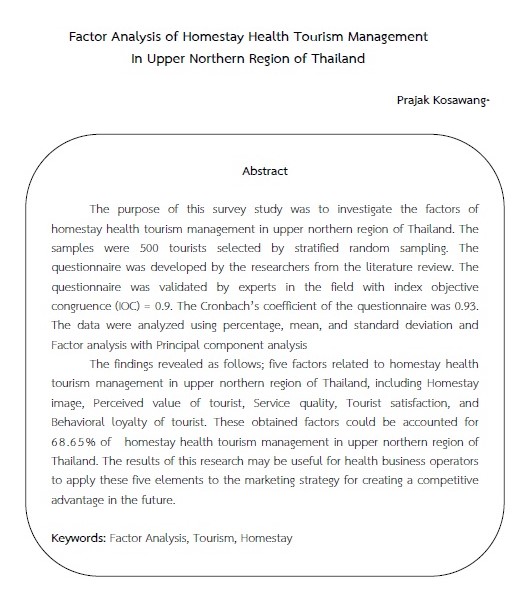การวิเคราะห์องค์ประกอบของการจัดการท่องเที่ยวเชิงสุขภาพโฮมสเตย์ ในเขตภาคเหนือตอนบนของไทย
บทคัดย่อ
งานวิจัยเชิงสำรวจนี้มีวัตถุประสงค์เพื่อศึกษาองค์ประกอบของการจัดการท่องเที่ยวเชิงสุขภาพโฮมสเตย์ ในเขตภาคเหนือตอนบนของไทย โดยทำการเก็บข้อมูลจากกลุ่มตัวอย่างนักท่องเที่ยวโฮมสเตย์ในเขตภาคเหนือตอนบน เลือกกลุ่มตัวอย่างแบบการสุ่มตัวอย่างแบบชั้นภูมิ (Stratified sampling) จำนวน 500 คน เครื่องมือที่ใช้คือ แบบสอบถามที่พัฒนามาจากการทบทวนวรรณกรรม ให้ผู้ทรงคุณวุฒิตรวจสอบความสอดคล้องระหว่างข้อคำถามกับวัตถุประสงค์ (IOC) ได้ค่าดัชนีความสอดคล้อง = 0.91 และนำไปทดสอบ (Try out) กับนักท่องเที่ยวที่ไม่ใช่กลุ่มตัวอย่าง จำนวน 30 คน ได้ค่าสัมประสิทธิ์แอลฟา (Cronbach's alpha coefficient) = 0.93 วิเคราะห์ข้อมูลด้วย ค่าความถี่ ร้อยละ ส่วนเบี่ยงเบนมาตรฐาน วิเคราะห์องค์ประกอบด้วยวิธีสกัดองค์ประกอบหลัก (Principal component analysis)
ผลการวิจัย พบว่า องค์ประกอบของการจัดการท่องเที่ยวเชิงสุขภาพโฮมสเตย์ ในเขตภาคเหนือตอนบนของไทย ประกอบด้วย 5 องค์ประกอบ ได้แก่ ภาพลักษณ์ของโฮมสเตย์ การรับรู้คุณค่าของนักท่องเที่ยว คุณภาพการให้บริการ ความพึงพอใจของนักท่องเที่ยว และความภักดีเชิงพฤติกรรมของนักท่องเที่ยว (การแสดงออกที่ชัดเจนของนักท่องเที่ยวที่จะกลับมาเที่ยวซ้ำ) ซึ่งทุกองค์ประกอบสามารถร่วมกันอธิบายการจัดการท่องเที่ยวเชิงสุขภาพโฮมสเตย์ในเขตภาคเหนือตอนบนของไทย ได้ 68.65% ผลการวิจัยสามารถนำไปเป็นประโยชน์สำหรับผู้ประกอบการธุรกิจด้านสุขภาพที่จะนำองค์ประกอบดังกล่าวไปประยุกต์ใช้กับการดำเนินกลยุทธ์ทางการตลาดเพื่อสร้างความได้เปรียบในการแข่งขันได้ในอนาคต
เอกสารอ้างอิง
New York: The Free.
Best, J.W. (1981). Research in Education. New Jersey: Prentice-Hall.
Cronin, J. J., Brady, M. K., & Hult, G. T. (2000). Assessing the effects of quality, value,
customer satisfaction on consumer behavioral intentions in service environments.
Journal of Retailing, 76(2), 193–218.
Getty, J. M., & Thompson, K. N. (1994). The relationship between quality, satisfaction, and
recommending behavior in lodging decision. Journal of Hospitality & Leisure
Marketing, 2(3):3-22.
Hair, J., Black, B. Babin, B., Anderson, R. and Tatham, R. (2006). Multivariate Data Analysis
(6th edition). Upper Saddle River, NJ: Prentice-Hall.
Kim, Y., K, & Lee, H.R., (2011). Customer satisfaction using low cost carriers. Tourism
Management, 32, 235-243.
Kotler, P. (1994). Marketing management analysis, planning, implementation, and control. (8th ed.). Englewood Cliffs: Prentice-Hall.
Kotler. (2000). Marketing Management Millenium Edition. (10th Ed). Prentice-Hall, Inc.
Kotler, P., & Armstrong, G. (2010). Principle of Marketing. (13th ed.). New Jersey: Prentice-Hall.
Lee, I., Choi, B., Kim, J., & Hong, S.J. (2007). Culture-technology fit: Effects of cultural
characteristics on the post-adoption beliefs of mobile Internet users. International Journal of Electronic Commerce, 11 (4), 11-51.
Likert, R. N. (1970). “A technique for the measurement of attitude”. Attitude Measurement.
Chicago: Ronal McNally & Company.
Oliver, R. L. (1999). What consumer loyalty? Journal of Marketing Research, 63(Special Issue): 33-44.
Oliver, R. L. (2010). Satisfaction: a behavioral perspective on the consumer. 2nd ed. Armonk, N.Y.: M.E. Sharpe.
Parasuraman, A., Zeithaml, V. A., & Berry, L. L. (1988). Servqual: A multiple-item scale for
measuring consumer perceptions of service quality. Journal of Retailing, 64(1), 12-40.
Parasuraman, A., & Grewal, D. 2000. The impact of technology on the quality-value loyalty
chain: A research agenda. Academy of Marketing Science Journal, 28(1), 168-174.
Kotler, Philip. (2009). Marketing Management. Upper Saddle River. New Jersey: Prentice-Hall.
Selnes, F. (1998). Antecedents and consequences of trust and satisfaction in buyer–seller relationships. European Journal of Marketing, 32, 305-322.
Sweeney, J. C., & Soutar, G. N. (2001). Consumer perceived value: The development of multiple item scale. Journal of Retaling, 77(2), 203-220.
Yuth kraiwan, 2013. Principles of research statistics, SPSS. 2nd ed. Bangkok: Chulalongkorn University Press
Zeithmal, V. A., Berry, L. L., & Parasuraman, A. (1996). The behavioral consequences of service quality. Journal of Marketing, 60(2), 31-46.
Zeithaml, V. A., Parasuraman, A., & Berry, L. L. (1990). Delivering Quality Service: Balancing Customer Perceptions and Expectations. New York: The Free Press.

ดาวน์โหลด
เผยแพร่แล้ว
ฉบับ
ประเภทบทความ
สัญญาอนุญาต
บทความ ข้อมูล เนื้อหา รูปภาพ ฯลฯ ที่ได้รับการตีพิมพ์ในวารสารวารสารวิชาการสุขภาพภาคเหนือ ถือเป็นลิขสิทธิ์ของวารสารวารสารวิชาการสุขภาพภาคเหนือ หากบุคคลหรือหน่วยงานใดต้องการนำทั้งหมดหรือส่วนหนึ่งส่วนใดไปเผยแพร่ต่อหรือเพื่อกระทำการใดๆ จะต้องได้รับอนุญาตเป็นลายลักอักษรจากวารสารวารสารวิชาการสุขภาพภาคเหนือก่อนเท่านั้น
เนื้อหาและข้อมูลในบทความที่ลงตีพิมพ์ในวารสารวิชาการสุขภาพภาคเหนือถือเป็นข้อคิดเห็นและความรับผิดชอบของผู้เขียนบทความโดยตรงซึ่งกองบรรณาธิการวารสาร ไม่จำเป็นต้องเห็นด้วย หรือร่วมรับผิดชอบใดๆ
อนึ่ง ข้อความและข้อคิดเห็นต่างๆ เป็นของผู้เขียนบทความนั้นๆ ไม่ถือเป็นความเห็นของวารสารฯ และวารสารฯ ไม่จำเป็นต้องเห็นด้วยกับข้อความและข้อคิดเห็นใดๆ ของผู้เขียน วารสารฯ ขอสงวนสิทธิ์ในการพิจารณาตีพิมพ์ตามความเหมาะสม รวมทั้งการตรวจทานแก้ไขหรือขัดเกลาภาษาให้ถูกต้องตามเกณฑ์ที่กำหนด


